Last week I showed you an all-white 1820s frock with a profusion of detailing. I expected that you would dislike the slightly raised waistline, the mish-mash of design inspiration, and the plain white fabric, but, much to my surprise, most of you liked it! Some of you thought it was fussy, and that the hem was particularly misplaced, bringing the score down to 8.3 out of 10.
Since last week’s all white frock went over so well, we’re going to stick to pale tones this week, with just a bit of bright hues and florals to lift the design.
Sadly, the Metropolitan Museum of Art gives very little information about this gown, so we’re going to have to do a bit of guessing as we rate it:
The dress is of silk satin trimmed with lace (probably linen), and is shaped almost entirely through the use of pintucks. Long graduated pintucks in the torso nip in the dress around the waist, and short horizontal pintucks down the front of the sleeves help the sleeves to curve with the arm
When I first saw the dress I thought the floral patterns might be warp-printing (chine a la branche), but a closer inspection reveals that they are appliques, and it almost looks as if they might be hand-painted.
The simple, smooth silhouette without a waist seam, paired with very feminine trimmings and light colours, suggests that this gown may be a tea gown.
The relatively simple back closure, hidden under the floral appliques in the upper back, supports this, as it would make the dress easy to don.
While the dress is simple in some respects, the overall construction is very clever – the pintuck shaping is inspired, and the pink and blue flowers are carefully balanced across the dress. Clever it may be, but does it work?
Rate the Dress on a Scale of 1 to 10.

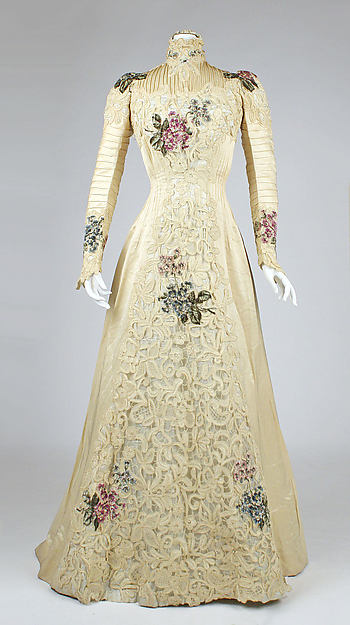
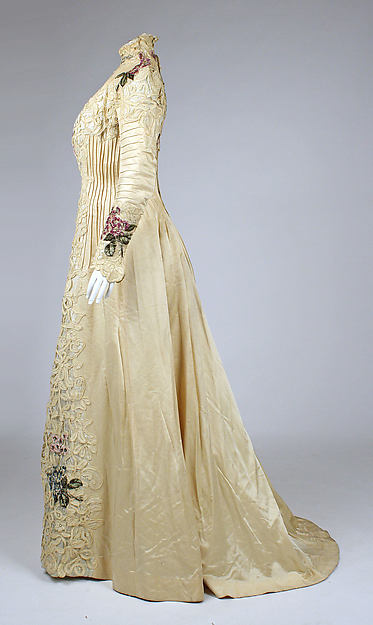
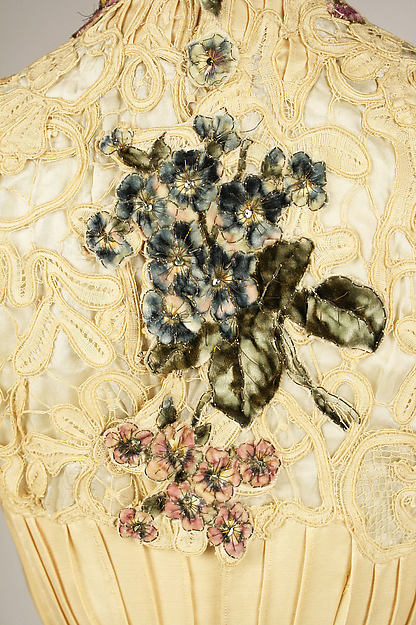
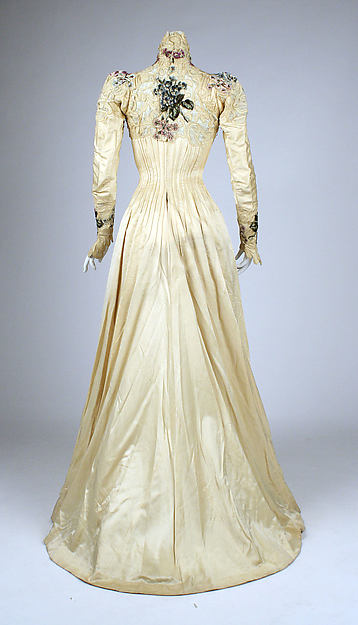
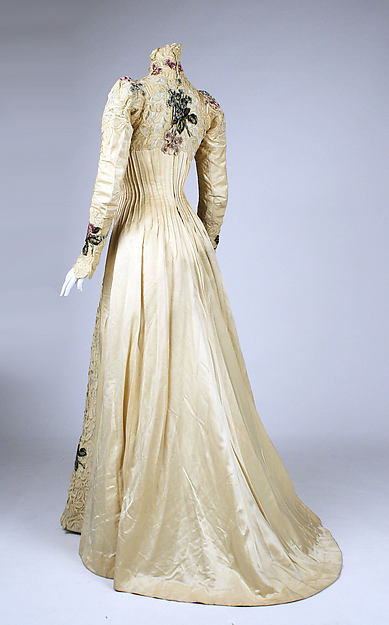
While the use of tucks is stunning, I find myself put off by the floral ornaments and the lace panel, because the scale seems overlarge, reminding me more of home furnishing fabric than garment fabric. 7 of 10.
I love the pin tucks and the overall silhouette of the dress. I love the pointed ends on the sleeves, and the high collar. I’m okay with the appliques–I don’t care much for the dark flowers on the pale off-white, but at least they are limited in number and not overdone. On the other hand, I don’t like the lace at all; I think it’s coarse and ugly and its prominent placement (down the entire front) cheapens the look of the dress in an unfortunate way. A 6.5.
I love so much about it–but find the applique placement too mannered to be graceful.
9/10
Is this sort of floral decoration typical of that time – big isolated flowers offset by a lot of negative space? It’s a very different effect from an allover floral decoration.
Aside from the deeply sloping bosom, I like the shape, especially in the skirt. I think I’m on board with the pin tucks – they do burden the dress with more designs, but they also give it dimension without going overboard on color or ornamentation.
Speaking of color and ornamentation – I like the big flowers, but I want them to be less symmetrical (maybe that’s too modern of me?) and gone from the shoulders entirely. But I think they complement all that creamy satin.
As for the lace – hello lacy guts! I mean, lacy viscera. I don’t think the owner of this dress would let me say guts in her presence. But the lace is big and wobbly and more distracting the more you look at it. But I do like that the front has that texture flowing down, so maybe a finer lace would have worked. Or some other subtler effect to draw the eye down over the smooth line of the waist and skirt.
It’s interesting, but I can’t say I love it or hate it. 7/10
Haha, ‘lacy guts’, that’s so on the money!
I was thinking it had a weirdly martial aesthetic for a while there (the flower appliques on the shoulders look like epaulettes and with the ones around the cuffs and the high collar and pale palette… it’s like a naval officer in dress whites had a run-in with a florist). If that was all it was, and it didn’t have the lacy guts I would have liked it a lot. Sadly I agree and think the lace is a bit heavy and detracts from the otherwise pleasing lines of the pintucks.
Without the lace it would have been a 9 from me, but with it I can’t bump it higher than 7.5.
Yes the dress may be simple in some respects, but it is totally over the top in others. For all that, the rich creamy colour is splendid, the use of tucks to shape the torso masterly. Points off for the horrible applique floral motifs.
6/10
Love the pin tucks, not so keen on the flowers but overall design is charming, 8/10
I love the silhouette! I also love the pin tucking and cream lace. The appliques…not so much. 8/10
Lovely shaping! So elegant, and so rich. It screams, “Look at me! I have money!” But in quite a polite way, and with nice vowels.
The colours are beautiful – warm yet subtle. The use of the floral appliques is really pleasing, except, perhaps, for the ‘Eve in the garden’ one on the front. And I love the high neck, and the lace.
9.5 out of 10. (Minus .5 for the full frontal primula.)
I love this dress. The use of pintucks is inspired (and inspiring). I like the appliques -when you think of how often at this time there would have been a superabundance of applique I feel their use is quite restrained. The lace is a bit heavy for the satin, but tastes have changed and this type of lace appears fairly often at this time. All in all, a very elegant frock. I give it a 10.
I love this dress and if I had the patience I would make it myself.
10/10
I like what they’ve done with the pintucks. That’s really clever and beautiful, and the colour is very nice. Overall though… no. I’m sorry, I don’t like it. I don’t like the lace and I agree with Cathy that it looks cheap (even though I’m sure it was expensive). I don’t like the appliques either. The mottled blue and green tones make me think of mould. If it was just the pink flowers the appliques might look nice, though the effect wouldn’t be as striking. 4/10.
I really like the silhouette and the decoration, well, most of it. The groinal one is poorly placed in my opinion and should have either been higher, or maybe on one hip rather than suggesting quite strongly about what is underneath.
8/10
The odd placement of the appliques in the skirt brings this down a lot in my first impression, I suspect… they either should have put in more, or left them off completely, or maybe just put more at the hem, something like that; in contrast I really like the way it’s placed on the bodice. When I bend my mind around that impression, I actually like this a lot. But the colour is still not very pleasant – might be discoloured with age or bad photo, for all I know, but the overall impression isn’t as good as I wish it were. It’s a good inspiration piece, though, in the “let’s see how I could make this work” style.
7/10
I love the skirt shape, very graceful. But the sloping bosom and high neckline is not for me. Also despite being mostly one colour there is so much going on its making my eyes water! I agree with there that the floral applique just doesn’t work. I can appreciate that technically it’s pretty amazing and would be a huge amount of work to create, but I would never want to wear it…. So I’m going for a very average 5/10
There are lovely floral dresses from the 1950s with flowers all over, but this is 1900 so it would be probably to blunt to do it here. As far as I can see those flower appliques are only used in the lace part of the the dress. If one imagines the lace part in a different colour from the satin part, one would see more clearly that the lace area has a controlled and symmetrical form (or even design). So in this area there could be a much more generous use of flower appliques all over. I don”t think that in this case the lace should be in a different colour than the satin, but it’s an option. I’m ok with creamy white but this is too faded for my liking and I’d prefer it a tad more white and fresh.7/10
I think the overall silhouette is very beautiful, very graceful and elegant, and the pintuck-y shaping thing is stunning.
The lace panel is a bit much, though, and so are the applications – I think they draw the attention away from the really amazing aspects of the dress.
So, 7.5/10
Like: fabric, color, silhouette, lace.
Dislike: flowers, pintucks.
7/10
I like the shape and the flowers and the lace, but the sleeves look strange. The tucks are horizontal when the rest of the gown’s are vertical and that makes them look like they belong to different gown, a much more military-inspired one. 8/10.
Nikki gives it an 8/10, Grace hates it so she gives it a 2/10, and I’m in between… I’d rather it didn’t have the appliques, so it’s 5/10 from me. Yeah, I know. we’re all over the place!
I like your family ratings. 🙂
I love the colours of this dress. It’s very Anne of Green Gables to me. And the pin-tuck shaping is so very clever. That being said, from the side view the pintucks look a bit odd. I loved the appliques on the skirt until someone pointed out the awkward placement. 7/10.
I love this dress. The shape and colors are beautiful although I think the neck would suffocate me. I give it a 9.
I adore the construction–I want to try the pintucks on the sleeves thing!
The lace looks like gros point de Venise, and as a maker of needlelace myself I appreciate the incredible work that goes into making those dimensional motifs. Although in this case, I think it’s imitation–at least I hope so, since I wouldn’t like to see someone chopping up some priceless church vestment or altar cloth to make a tea gown!–maybe Battenburg lace embellished with soutache, or a large-scale bobbin lace made with thicker thread. In this gown, I like the weight and chunkiness of the lace; I think softer lace would look insipid.
In the same way, the dark flower appliques, positioned firmly and neatly, are decided in tone. The message this dress sends me is of an older, bolder woman who nods to the convention of softly colored tea gowns but still has something forceful to say.
I give it 8/10 for having personality and sticking to it.
After reading all the comments I had to go back up to the top to look at the dress again. I’ve always had a “thing” for Gibson Girl tea gowns. However, I could never wear this in the summer. On to my thoughts: I absolutely loved the pintucks — and especially around the waist; I went back and forth on the lace and finally decided that the gown did in fact need the lace to be heavier than what we are used to; the same amount of scrutiny went into the appliques, which were fairly placed; the silk satin material is just to die for.
Anyway, my final rating for this dress is: 8.5/10
I think it suffers from “too much”. It would have been prettier if the bodice were left as is, add a sash about the waist, and have only a ring of lace about the mid calf with a couple of floral details. The full lace panel plus the pintucks just makes it seem like the dress is trying too hard. 6 out of 10.
It’s lovely. Though most of the interest is in the front, I am most fond of the back and love the drape it has. It’s marvelous that pintucks were used with such finesse and expertise. 9
7/10 Lovely especially the back. Pintucking adds to the gracefulnes, especially the sleeves. Appliqued flowers seem a bit too much…with the lace that is. The lace is wonderful!! I woulf love to see this dress in a light blue satin with the ivory lace overlay…sigh.
There is a suggestive eroticism in the placing of the foliage that puts me in mind of the
East/West confluence of the Theosophical Society that was trending in America
at the time this garment was fashioned. In the ‘language of flowers’, which is how
the Victorians couched their deeper feelings, the wearer of this dress could be
saying: I’ve read the Kama Sutra.
The floral motifs look like pansies which in the language of refined and modest
Courtship, signalled: “I think of you”.
Turning to the Old Testament, the placement of the motifs on the dress could
be a most creative couterier’s interpretation of the Seal of Solomon for a bridal dress.
Set me as a seal upon thine heart, as a seal upon thine arm:
for love is strong as death; jealousy is cruel as the grave:
the coals thereof are coals of fire, which hath a most vehement flame.
E. Stauffer is an interesting name.
7/10
Want to like it but just don’t. I realise it might be aged off white, but I just don’t like the colour. Or the lace.. Or the floral appliques. 4/10
LOVE grace’ comment above about the Kama sutra. Certainly makes the dress more interesting! If the dress were really secretly communicating all that, it would go up to 10/10.
Love the way the pin tucks give it the shape but the flowers look like they have been plonked on to hide something. Would be elegant with just the lace